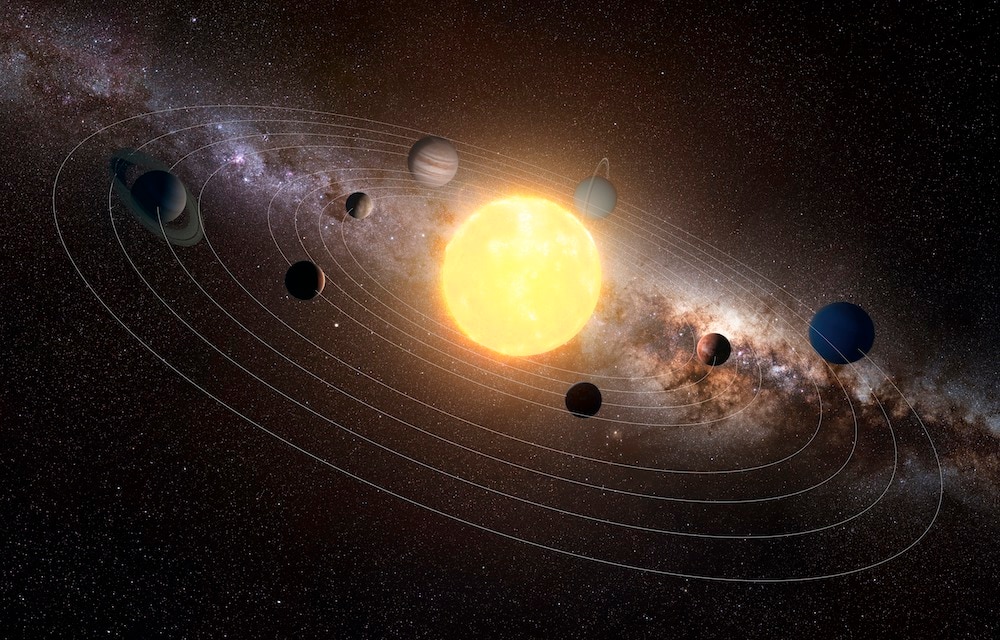Create a free profile to get unlimited access to exclusive videos, sweepstakes, and more!
We live in a star system more alien than most
The way that our solar system was shaped by pressure bumps and rings made it unusual in more than one way.

As much as we are used to living in the solar system, it would look downright weird to any hypothetical aliens peering through their hypothetical telescope.
Everything was smashing into everything else as the solar system formed billions of years ago. Particles of dust would collide and stick to each other, until they turned into pebbles, which crashed and stuck together, and chunks of rock would grow larger and larger until they accreted enough material to become rocky planets. However, that could only happen in a region where the pressure was exactly what they needed.
In younger systems that have been observed, their protoplanetary discs of gas and dust show up as having rings that are really “pressure bumps” which indicate a significant change in pressure. Researcher Andre Izidoro of Rice University, who led a study recently published in Nature Astronomy, simulated different regions of pressure in the early disc to find out how rocky planets came to dominate the inner solar system.
“In these simulations, pressure bumps are usually associated with snow lines, locations in the disc where vapors (such as water and CO2) condense into solid ice,” he told SYFY WIRE. "Pressure bumps may also be associated with regions [in] the disk where the gas becomes ionized or appear in the disk due to turbulence caused by the effects of magnetic fields.”
When an object that comes hurtling into the inner solar system is full of CO2 ice, you know it couldn’t have possibly formed around here because that snow line lies in the far reaches of the outer solar system. Protoplanetary water morphs into ice at about -153 degrees Fahrenheit. The water ice snow line is thought to have been between Mars and Jupiter when the solar system was still forming. Earth and the other three rocky planets — Venus is still a rocky planet even though it is shrouded in toxic clouds — were born within that line without burning up.
Mercury just barely hung on. It used to be a huge glob of magma, but scorching temperatures from the Sun (which blazed hotter when it was younger) evaporated much of that magma ocean. That’s right — it was hot enough to vaporize rock. Some of its atmosphere still gets ionized when particles from plasma carried by the solar wind collide with atoms in its atmosphere and either add or knock out an electron. At the other extreme, beyond the water ice snow line Jupiter, Saturn, Neptune, and Uranus grew into monstrous gas giants.
But why is Mars so much smaller than it should have been under previous assumptions of how the solar system came into being?
“Mars should have been as big as the Earth if the solar system formed from a smooth disk without rings," said Izidoro. “The pressure bumps and rings in our model of the protoplanetary disc explain why Mars is so small, along with other characteristics of the solar system.”
This is just one of the ways the simulation results connect the Sun’s protoplanetary disc to what the solar system and the objects in it look like now. There is no way it could have formed from a smooth disc. Mars is only a tenth of Earth’s mass, which would not have been possible without pressure bumps that allow planets to start forming at a certain point and stop their formation at an upper limit. This also explains why an asteroid belt exists.
Our solar system is still particularly rare in the cosmos. While exoplanets between the size of Earth and Neptune are extremely common, these super-Earths and hot Neptunes usually orbit their stars much closer than even Mercury. Hot super-Earths are thought to lurk around 30-50% of Sun-like stars. So why don’t they get vaporized? It depends on the star, the orbit, the orbital velocity, and many other factors. They also could have formed further out and migrated.
“We believe that in our solar system Mercury, Venus, Earth, and Mars did not become hot super-Earths because rings controlled their growth which prevented them from migrating much closer to the sun,” Izidoro said.
That doesn’t mean the systems of these planets have no bumps or rings. If rings take too long to trap the dust swirling in the exo-equivalent of the region where Earth formed, they blow up into super-Earths and move toward their stars.
So we live in an anomaly. Maybe we really are the aliens, after all.


























